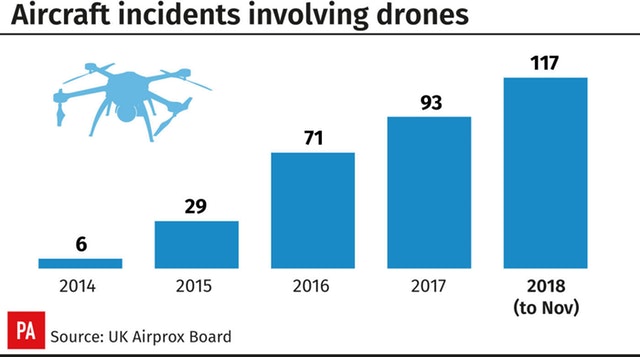Drone Disruptions at Gatwick, December 2019
Hundreds of flights have been canceled December 20 and 21 2018 and tens of thousands of airline passengers have been stranded because of the buzz of unauthorized drones over London’s Gatwick Airport — demonstrating how disruptive a simple aerial strategy can be.
British regulations call for a no-drone zone within 1 kilometer (0.6 miles) of an airport’s perimeter, while the Federal Aviation Administration restricts drone flights in a five-mile radius around airports such as Seattle-Tacoma International Airport.
In more sensitive areas, such as the National Capital Region around Ronald Reagan Washington National Airport, restrictions are in force within a much wider radius — ranging from 15 to 30 miles, depending on the type of activity.
The persistent drone crisis at Gatwick, located 45km south of London and which serves 43 million passengers a year, has had ripple effects throughout the international air travel system.

The Gatwick drone disruption is clearly not the only one as the chart above highlights. And the problem is a ongoing challenge facing airports as well as other technologies such as laser technologies.
A press release from Drone Shield, an Australia company also based in the US provided a comment on the incident and highlighted their technologies available to deal with drone defeat.
According to press reports and statements by UK government officials, one or more drones were flown by unknown operators in the airport’s airspace, causing the airport to shut down all air traffic for a period of approximately 48 hours.
The UK Transport Minister was quoted as having said, “Every time Gatwick tries to reopen the runway, the drones reappear.” The shutdown stranded well over 100,000 passengers during some of the busiest times of the year for travel and caused tens if not hundreds of millions of dollars of damage to a range of companies. The drone overflights are likely to be an act of sabotage, which are said to have overcome the drone control measures that were reported to have been deployed at the airport.
The British Army was reported to have been called in to assist with lifting this effective blocade of the airport, and the press noted the limited range of options available to remedy the situation, as well as the fact that the Army had ruled out shooting the drones down with conventional (kinetic) weapons because of concerns about the unintended consequences of firing at the airport.
Several important lessons can be drawn from the events at Gatwick.
- Drone misuse is a universal problem. There is virtually no government in the world that does not require protection against drones, as do large numbers of commercial users (such as stadiums, event venues, power plants, airports and others).
- Inaction is not an option. The costs of inaction are huge, and drone attacks will continue to proliferate, grow in sophistication, and intensify.
- Many purported drone mitigation products are concepts in development and have not been deployed at all or have only been tested in a narrow range of situations or controlled environments.
- Cost is not a predictor of performance. The media has reported that systems that could cost up to £20 million (US$26 million) were brought in to deal with the rogue drones. Nevertheless, the drones were not defeated for approximately 48 hours.
- The cost of many drone mitigation systems renders it prohibitive for most “soft” targets to use these expensive systems on a day to day basis.
The Drone Shield press release went on to describe the systems which they have developed and delivered to deal with a defeat drone scenario.
DroneShield is one of the very few companies in the counterdrone industry that have progressed to products that have been proven in a range of environments, against a range of drones, with multiple governmental users.
Importantly, the price range of DroneShield’s drone detection and mitigation products varies from tens of thousands of dollars per unit at the low end to approximately a million dollars at the high end, a fraction of what several competing systems are priced at.
As a result, just in the recent months alone, DroneShield:
- received an initial order for its counterdrone equipment from Zain (KWSE:ZAIN), one of the largest Middle Eastern telecoms, following an entry into a Teaming Agreement for the Middle East with Zain;
- sold a substantial amount of anti-drone equipment to one of the largest Middle Eastern Ministries of Defence;
- sold its portable drone jammers DroneGun™ for use by a Western governmental security agency;
- sold DroneGuns™ for use by the national security agency of a major Asian country;
- sold DroneSentry™ (DroneShield’s integrated multi-sensor drone detection and mitigation system), as well as DroneGuns™ to a Central American government security agency;
- teamed up with Thales (ENXTPA:HO) on servicing Thales’ anti-drone needs in Spain;
- had its products evaluated by the United States Department of Defense’s Assymetric Warfare Group at Fort A.P. Hill, Virginia;
- had its DroneSentinel™ multi-sensor drone detection system used by the British military at the Autonomous Warrior 2018 exercise; and
- added DroneShield’s products to the Australian Government’s 2019 Australian Military Sales Catalogue, maintained by AMS (Australian Military Sales), a Directorate within the Australian Government’s Defence’s Capability Acquisition and Sustainment Group.
DroneShield’s products have been deployed for counterdrone security at, among others:
- an ASEAN meeting of heads of state;
- several Boston Marathon events over the years;
- the PyeongChang 2018 Olympics;
- the 2018 XXI Commonwealth Games;
- the IRONMAN World Championship;
- the 2018 Paraguay presidential inarguration; and
- at a number of military deployments globally.
Oleg Vornik, DroneShield’s Chief Executive Officer, commented, “We expect that this latest incident involving a major airport will result in airports and other civil infrastructure users around the world accelerating their implementation of drone mitigation measures. DroneShield, and our network of approximately 60 distributors in approximately 50 countries, stand ready to assist qualified customers with their drone security needs.
